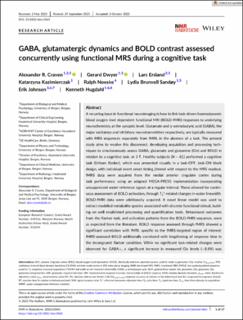| dc.description.abstract | A recurring issue in functional neuroimaging is how to link task-driven haemodynamic blood oxygen level dependent functional MRI (BOLD-fMRI) responses to underlying neurochemistry at the synaptic level. Glutamate and γ-aminobutyric acid (GABA), the major excitatory and inhibitory neurotransmitters respectively, are typically measured with MRS sequences separately from fMRI, in the absence of a task. The present study aims to resolve this disconnect, developing acquisition and processing techniques to simultaneously assess GABA, glutamate and glutamine (Glx) and BOLD in relation to a cognitive task, at 3 T. Healthy subjects (N = 81) performed a cognitive task (Eriksen flanker), which was presented visually in a task-OFF, task-ON block design, with individual event onset timing jittered with respect to the MRS readout. fMRS data were acquired from the medial anterior cingulate cortex during task performance, using an adapted MEGA-PRESS implementation incorporating unsuppressed water-reference signals at a regular interval. These allowed for continuous assessment of BOLD activation, through T2*-related changes in water linewidth. BOLD-fMRI data were additionally acquired. A novel linear model was used to extract modelled metabolite spectra associated with discrete functional stimuli, building on well established processing and quantification tools. Behavioural outcomes from the flanker task, and activation patterns from the BOLD-fMRI sequence, were as expected from the literature. BOLD response assessed through fMRS showed a significant correlation with fMRI, specific to the fMRS-targeted region of interest; fMRS-assessed BOLD additionally correlated with lengthening of response time in the incongruent flanker condition. While no significant task-related changes were observed for GABA+, a significant increase in measured Glx levels (~8.8%) was found between task-OFF and task-ON periods. These findings verify the efficacy of our protocol and analysis pipelines for the simultaneous assessment of metabolite dynamics and BOLD. As well as establishing a robust basis for further work using these techniques, we also identify a number of clear directions for further refinement in future studies. | en_US |

